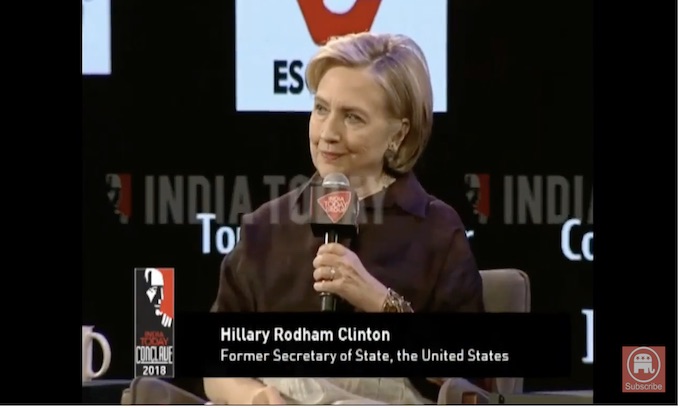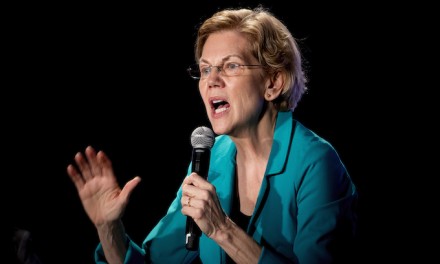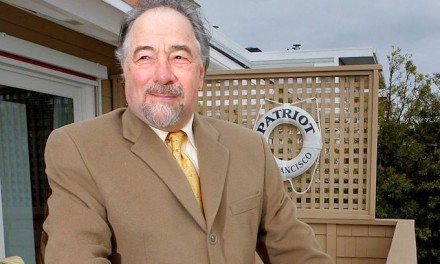It’s a mystery. On the premise that Hillary Clinton is one of the smartest women in the world and a feminist icon, none of it makes any sense.
Perhaps there is a flaw in the premise.
Clinton recently took her “What Happened” book tour to India, where she described the outcome of the 2016 election with these words:
“If you look at the map of the United States, there’s all that red in the middle where Trump won. I win the coast. I win, you know, Illinois and Minnesota — places like that.”
Places like what, exactly? Places with characteristics that “the map doesn’t show you,” she told the interviewer.
“I won the places that represent two-thirds of America’s gross domestic product,” Clinton said. “So I won the places that are optimistic, diverse, dynamic, moving forward.”
And her opponent? “His whole campaign — ‘Make America Great Again’ — was looking backward. You know, you didn’t like black people getting rights; you don’t like women, you know, getting jobs; you don’t want to, you know, see that Indian American succeeding more than you are — you know, whatever your problem is, I’m gonna solve it,” Clinton explained.
Apparently, in the confusion of changing over to daylight saving time, Hillary Clinton set her clocks back to 1964.
That was the year Alabama’s segregationist governor, George Wallace, did better than expected in the Democratic presidential primaries, leading him to try again in 1968 as a third-party candidate. He ran on a platform of law-and-order and states’ rights to maintain racial segregation.
Wallace ended up carrying five states — Alabama, Arkansas, Georgia, Louisiana and Mississippi — totaling 45 electoral votes.
Also in 1964, author Betty Friedan sold more than one million copies of “The FeminiAne Mystique,” the breakthrough book challenging the widely held belief that women in post-World War II America would find fulfillment in life only as housewives and mothers.
In 1968, people who “didn’t like black people getting rights” and who “don’t like women, you know, getting jobs” were still a significant factor in politics.
But that was 50 years ago when Hillary Clinton was 20, not two years ago when she was a candidate for president.
Clinton plunged deeper into the past with her explanation of why white women voted for Donald Trump. She said these female voters had given in to “ongoing pressure to vote the way that your husband, your boss, your son, whoever, believes you should.”
That’s about 100 years out of date, reaching back to the days of the “woman suffrage” debate.
The U.S. Constitution was amended in 1920 to give women the right to vote, but the question was on many state ballots years earlier. In California, voters were asked in 1911 to decide the issue with Senate Constitutional Amendment 8, on the ballot as Proposition 4.
The voters’ information manual included an argument against the measure written by Senator J. B. Sanford, chairman of the Democratic Caucus. “The mother’s influence is needed in the home,” Sanford wrote. “The men are able to run the government and take care of the women. Do women have to vote in order to receive the protection of man?”
Sanford’s recommendation was to “keep woman where she belongs in order that she may retain the respect of all mankind.”
California voters narrowly approved Proposition 4 with 50.7 percent support. It had the least support, 38.1 percent, in San Francisco, later home to the first female speaker of the House.
Although Clinton made it a point to present her candidacy as a groundbreaking feminist milestone, her presidential campaign may actually have its origins in the early 20th century practice known as the “widow’s mandate” or “widow’s succession.”
Between 1923 and 1934, eight women who served in Congress were widows who won special elections to fill their late husband’s seats. “Party leaders believed in the value of having the same familiar last name on the ballot,” according to a history of women in Congress on the website of the U.S. House of Representatives.
Bill Clinton wasn’t dead, of course, but term limits have the same effect. A well-known name, a robust fundraising operation and the sympathy of voters will keep all the advisors and staff members securely employed, even if the candidate is not the brightest bulb in the chandelier.
Now out of office and no longer a candidate, Hillary Clinton is speaking in public without the filter of a highly skilled political communications team.
The carefully crafted image is dissolving. What’s underneath it should give everybody shivers.
Susan Shelley is an editorial writer and columnist for the Southern California News Group. Reach her at [email protected] and follow her on Twitter: @Susan_Shelley.
___
(c)2018 The Orange County Register (Santa Ana, Calif.)
Visit The Orange County Register (Santa Ana, Calif.) at www.ocregister.com
Distributed by Tribune Content Agency, LLC.
—-
This content is published through a licensing agreement with Acquire Media using its NewsEdge technology.




















Recent Comments